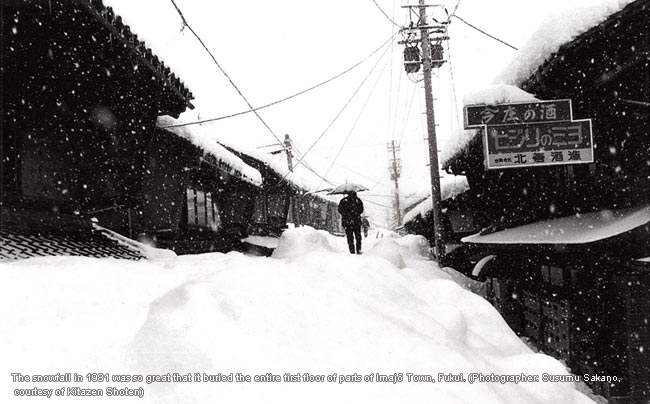
It goes without saying that the Hokuriku Region is part of "Snow Country", a phrase which stirs up people's passion for traveling and continues to attract people from regions where snowfall is scarce.
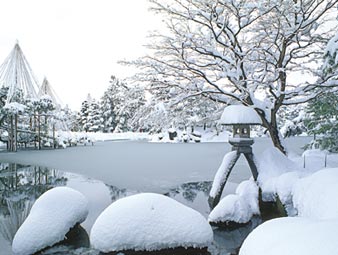
Snow-covered Kenrokuen Garden
However, for the people living in this area snow also has a dangerous side. The winter in Hokuriku is not very cold but the region gets a heavy amount of snowfall which contains a lot of moisture, resulting in considerable snow accumulation. As a result, people have to work hard to clear the heavy snow from their roofs or surrounding streets. A good example of this is Kenrokuen Garden's "yukizuri" (straw ropes attached to the branches of trees to protect them from snow fall). It is a famous winter attraction and is often considered as a decoration meant for tourists, but in reality, yukizuri carries the important job of preventing tree branches from breaking due to heavy snowfall. This yukizuri technique can also be seen on the streets or at people's houses.
The coastal areas of the Japan Sea are known for extremely heavy snowfalls, and even within this area, the mountainous regions of Niigata, Toyama, Ishikawa, and Fukui Prefectures are said to have some of the heaviest snowfall in all of Japan.
A common characteristic often attributed to the people of Hokuriku is "perseverance" which is said to be the result of a lifestyle shaped by snowy climate. People in the Hokuriku area do not just sit around patiently waiting for the snow to melt; they live in harmony with the snow and have learned over the years how to skillfully use the snow for their own benefits.
Traditional Wisdom Gained from Heavy Snowfall
The town of Imajō, formerly known as Minami-Echizen, is considered to be one of the places with the most snow in Fukui Prefecture. It prospered as a post town (shukuba-machi, literally an "inn town") because of its location as the first post station in the Hokuriku area for travelers northbound on the Hokuriku-Kaidō route and the Hokkoku-Kaidō route. The town is also famous for its production of delicious sake (Japanese rice wine), brewed with neutral pH and ultra-soft water that springs out in abundance from the large quantities of snow that melts and passes through a base rock layer of silica. With these two natural geographical advantages, sake brewing has been a flourishing business in Imajō for many generations.
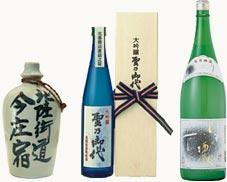
Kitazen Shoten sake, limited to the winter season.
Even today there are four sake breweries along the old Hokuriku-Kaidō route near the JR Imajō Station.
Kitazen Shoten is one of those breweries, and the owner is himself a master brewer. According to Noriyasu Kitamura, the 10th generation owner of Kitazen Shoten, in order to brew sake using the Hokuriku-style low-temperature technique, the outdoor temperature should be 2°C to 3°C and the brewery temperature 5°C to 6°C. Changes in temperature affect the yeast activity and, consequently, the quality of the sake. However, snowfall stabilizes the temperature at night, and even if it is sunny during the day, temperature fluctuations are kept to a minimum, maintaining ideal conditions. That is why areas with heavy snowfall are ideal for brewing sake.
Mr. Kitamura says, "Before I go to bed, I look up at the night sky. If it is a starry night, it means that nocturnal radioactive cooling will cause a dip in the temperature, which is a matter of concern. However, if it snows, then I can sleep in peace."
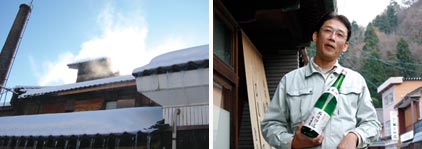
(Left) Steam rises above the sake brewery. (Right) Mr. Noriyasu Kitamura
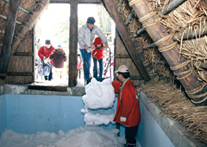
Preparing the himuro

Himuro manjū, now eaten on July 1st
Before there were electric refrigerators, only the privileged elite class had ice in the summer. This involved constructing a "himuro" (ice room) or "yukimuro" (snow room) to store food and preserve ice for use in the summer or for cooling down fevers. While this was not something just anyone could enjoy, in the Hokuriku area, a greater number of people were able to enjoy this privilege, which was available at a lower cost.
The Kaga Clan (the name of the local government that controlled the part of the Hokuriku area during the Edo Period) would open the himuro on the first day of the sixth month of the lunar year for the "Himuro Festival", a day when ice was presented to the Shogunate (central government). On this day, the people would eat himuro manjū (a pastry with red-bean inside) and pray for good health and safety, as well as for the ice's safe arrival in Edo (present-day Tokyo).
Living In Harmony With the Snow in Old Japan
In the Hokuriku area, the day-to-day life scene that best matches with the snowy weather is the Gokayama Gassho Village. The gassho-style house is built with a steep roof made of several layers of thatched straw; the inside of the house contains a number of levels. In the past, a variety of activities such as cultivating silkworms would have taken place in these houses. They also produced Japanese paper in these houses, and, instructed by the Kaga Clan, built explosives under the floor and hid them from the Shogunate.
Gokayama is still known as a producer of Japanese paper, and the "yukisarashi" technique was also revived here by the Higashi Nakae Japanese Paper Manufacturing and Production Guild. The main raw material (the bark of the paper mulberry tree) is first laid down on the snow and exposed, after which the bark decolorizes. The fibers then soften, helping to create Japanese paper that is delicate and fine. This used to be a very common sight in the snowy areas where Japanese paper was produced, but nowadays, many of the steps are completed with the use of chemicals. Gokayama is now one of the only places this technique can still be seen. This paper is called "kansuki" and the best quality paper is produced in the winter season. Take a visit to Gokayama to see the production of kansuki and also to try some hands-on activities.
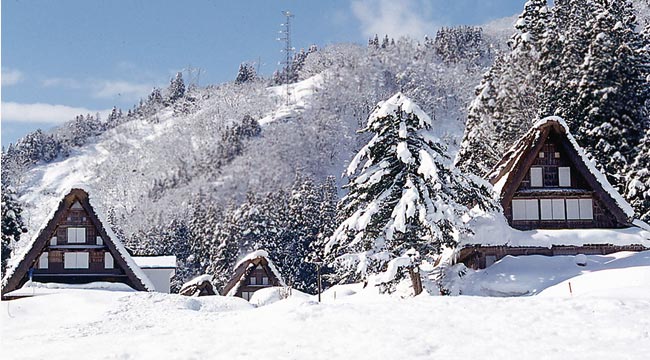
The World Heritage Site at Ainokura Gassho Village covered in snow. (Nanto City)
 (Left) Stripping the bark from the paper mulberry tree; (Middle) Exposing and placing the tree bark in the snow; (Right) This gassho-style house in Suganuma Village shows how gunpowder was made in the past.
(Left) Stripping the bark from the paper mulberry tree; (Middle) Exposing and placing the tree bark in the snow; (Right) This gassho-style house in Suganuma Village shows how gunpowder was made in the past.
The Must-See Winters of Snow Country
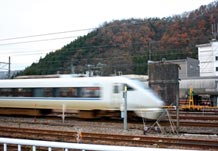
Imajō is also famous for soba noodles (Japanese noodles made of buckwheat). In the past, when steam locomotives ran on the Hokuriku Main Line, trains would stop for a long time at Imajō Station before attempting the crossing over the mountain pass. It is said that passengers looked forward to the wait time, during which they would go and sample some of the soba noodles at the station. This soba became very well-known, and soon was popular all over Japan.
In their daily lives, people used to eat sobagaki (buckwheat dumplings), but on special days, such as New Year's Day, festivals, or days when they have guests, people in Imajō would make sobakiri (buckwheat noodles).
"We used to boil water in an iron tea kettle hung above the irori (sunken fireplace) and immerse the soba in it. The hot soba was very delicious with the cold, grated daikon radish and home-made soy sauce. The radish has a bit of a kick and goes well with the hot noodles, warming up your body," says Mr. Kazuyoshi Terada, owner of a soba shop called "Imajō Soba-no-Sato". Sitting by the irori while eating soba noodles and watching the snow falling silently outside would make anyone feel a sense of nostalgia for old Japan. Mr. Kitamura says, "Soba and sake make a perfect combination. I love drinking sake with a bit of soba." When people from Imajō start to talk about soba, it never ends.

(Left) At the Imajō Soba Dōjō, you can try making soba; (Right) One of Imajō's specialties is the grated daikon radish soba dish.
Good sake and soba can be found not only in Imajō, but in almost every mountainous region of the Hokuriku area.
Tasting fresh winter sake with delicious new soba can only be enjoyed in sake-producing districts. Sample the tastes of Hokuriku from inside a warm house while watching the snow falling outside. If you are an adult who loves snow, you will definitely enjoy the Hokuriku winters.

